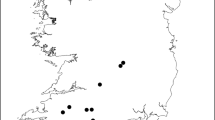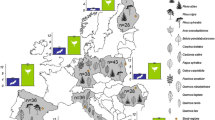Abstract
Although an increasing number of studies have shown that diverse, multi-strata agroforestry systems can contribute to the conservation of tropical biodiversity, there is still debate about how the biodiversity within agroforestry systems compares to that of intact forest and alternative land uses. In order to assess the relative importance of agroforestry systems for biodiversity conservation, we characterized bat and bird assemblages occurring in forests, two types of agroforestry systems (cacao and banana) and plantain monocultures in the indigenous reserves of Talamanca, Costa Rica. A total of 2,678 bats of 45 species were captured, and 3,056 birds of 224 species were observed. Agroforestry systems maintained bat assemblages that were as (or more) species-rich, abundant and diverse as forests, had the same basic suite of dominant species, but contained more nectarivorous bats than forests. Agroforestry systems also contained bird assemblages that were as abundant, species-rich and diverse as forests; however the species composition of these assemblages was highly modified, with fewer forest dependent species, more open area species and different dominant species. The plantain monocultures had highly modified and depauperate assemblages of both birds and bats. Across land uses, bird diversity and species richness were more closely correlated with the structural and floristic characteristics than were bats, suggesting potential taxon-specific responses to different land uses. Our results indicate that diverse cacao and banana agroforestry systems contribute to conservation efforts by serving as habitats to high numbers of bird and bat species, including some, but not all, forest-dependent species and species of known conservation concern. However, because the animal assemblages in agroforestry systems differ from those in forests, the maintenance of forests within the agricultural landscape is critical for conserving intact assemblages at the landscape level.


Similar content being viewed by others
References
Benton TG, Vickery JA, Wilson JD (2003) Farmland biodiversity: is habitat heterogeneity the key? Trends Ecol Evol 18:182–188
Blas D, Blas L, Solana T (2003) Guía de campo ilustrada de las aves de Costa Rica. Incafo Costa Rica, S. A. Madrid.
Carlo TA, Collazo JA, Groom MJ (2004) Influences of fruit diversity and abundance on bird use of two shaded coffee plantations. Biotropica 36(4):602–614
Dahlquist, R. M., Whelan MP, Winowiecki L, Polidoro B, Candela S, Harvey CA, Wulfhorst JD, McDaniel PA, Stoian D, Bosque-Perez NA (2007) Incorporating livelihoods in biodiversity conservation: a case study of cacao agroforestry systems in Talamanca, Costa Rica. Biodivers Conserv (this issue)
Daily GC (2001) Ecological forecasts. Nature 411:245
Daily GC, Ehrlich PR, Sanchez-Azofeifa GA (2001) Countryside biogeography: use of human dominated habitats by the avifauna of southern Costa Rica. Ecol Appl 11:1–13
Estrada A, Coates-Estrada R, Merritt DA (1997) Anthropogenic landscape changes and avian diversity at Los Tuxtlas, Mexico. Biodivers Conserv 6:19–42
Estrada A, Cammarano PL, Coates-Estrada R (2000) Bird species richness in vegetation fences and in strips of residual rain forest vegetation at Los Tuxtlas, Mexico. Biodivers Conserv 9:1399–1416
Estrada A, Coates-Estrada R (2001a) Species composition and reproductive phenology of bats in a tropical landscape at Los Tuxtlas, Mexico. J Trop Ecol 17:627–646
Estrada A, Coates-Estrada R (2001b) Bat species richness in live fences and in corridors of residual rain forest vegetation at Los Tuxtlas, Mexico. Ecography 24:94–102
Faria DR, Laps R, Baumgarten J, Cetra M (2006) Bat and bird assemblages from forests and shade cacao plantations in two contrasting landscapes in the Atlantic Forest of southern Bahia, Brazil. Biodivers Conserv 15: 587–612
Fenton MB, Acharya L, Audet D, Hickey MBC, Merriman C, Obrist MKD, Syme M (1992) Phyllostomid bats (Chiroptera: Phyllostomidae) as indicators of habitat disruption in the Neotropics. Biotropica 24(3):440–446
Fleming TH (1991) The relationship between body size, diet, and habitat use in frugivorous bats, genus Carollia (Phyllostomidae). J Mammal 72:493–501
González J (1999) Diversidad y abundancia de aves en cafetales con y sin sombra. Ciencias Ambientales 17:70–80
Gotelli NJ, Entsminger GL (2000) Ecosim: null models software for Ecology. Acquired Intelligence Inc and Kesey-Bear
Harvey CA, Alpizar F, Chacón M, Madrigal R (2005) Assessing linkages between agriculture and biodiversity in Central America: historical overview and future perspectives. Mesoamerican & Caribbean Region, Conservation Science Program. The Nature Conservancy (TNC), San José, Costa Rica
Harvey CA, González J, Somarriba E (2006a) Dung beetle and terrestrial mammal diversity in forests, indigenous agroforestry systems and plantain monocultures in Talamanca, Costa Rica. Biodivers Conserv 15:555–585
Harvey CA, Medina A, Merlo Sánchez D, Vílchez S, Hernández B, Sáenz JC, Maes JM, Casanoves F, Sinclair FL (2006b) Patterns of animal diversity associated with different forms of tree cover retained in agricultural landscapes. Ecol Appl 16(5):1986–1999
Henriques W, Jeffers RD, Lacher T, Kendall RJ (1997) Agrochemical use on banana plantations in Latin America: perspectives on ecological risk. Environ Toxicol Chem 16:91–99
Herrera W (1985) Vegetación y clima de Costa Rica. San Jose, EUNED
Hole DG, Perkins AJ, Wilson JD, Alexander IH, Grice PV, Evans AD (2005) Does organic farming benefit biodiversity? Biol Conserv 112:113–130
Hughes JB, Daily GC, Ehrlich PR (2002) Conservation of tropical forest birds in countryside habitats. Ecol Lett 5:121–129
Ibarra I, Arriaga S, Estrada A (2001) Avifauna asociada a dos cacaotales tradicionales en la región de la Contalpa, Tabasco, México. Universidad y Ciencia 17(34):101–112
InfoStat (2004) InfoStat versión1.4. Grupo InfoStat, FCA, Universidad Nacional de Córdoba, Argentina
Johns ND (1999) Conservation in Brazil’s chocolate forest: the unlikely persistence of the traditional cocoa agroecosystem. Environ Manage 23(1):31–47
Johnson MC (2000) Effects of shade tree species and crop structure on the winter arthropod and bird communities in a Jamaican shade crop plantation. Biotropica 32(1):133–145
Laval R, Rodriguez B (2002) Murciélagos de Costa Rica, 1st edn. INBio, Santa Domingo de Heredia, Costa Rica
Lawton JH, Bignell DE, Bolton B, Bloemers GF, Eggleton P, Hammon PM, Hodd M, Holt RD, Larsen TB, Mawdsley NA, Stork NE, Srivastava DS, Watt AD (1998) Biodiversity inventories, indicator taxa and effects of habitat modification in tropical forest. Nature 391:72–76
Luck GW, Daily GC (2003) Tropical countryside bird assemblages: richness, composition and foraging differ by landscape context. Ecol Appl 13:225–247
Magurran AE (1988) Ecological diversity and its measurement. Princeton University Press, Princeton, New Jersey
McAleece N (1997) BioDiversity Professional. The National History Museum and The Scottish Association For Marine Science. Version Beta. http://www.nhm.ac.uk/zoology/bdpro
McNeely JA, Scherr SJ (2003) Ecoagriculture: strategies to feed the world and save biodiversity. Island Press, Washington, DC
Medellín RA, Equihua M (1998) Mammal species richness and habitat use in rainforest and abandoned agricultural fields in Chiapas, Mexico. J Appl Ecol 35:13–23
Medina A, Harvey CA, Sánchez D, Vílchez S, Hernández B (2007) Bat diversity and movement in a neotropical agricultural landscape. Biotropica 39(1):120–128
Miller K, Chang E, Johnson N (2001) Defining the common ground for the Mesoamerican biological corridor. World Resources Institute, Washington, DC
Moguel P, Toledo VM (1999) Biodiversity conservation in traditional coffee systems of Mexico. Conserv Biol 13(1):11–21
Municipality of Talamanca (2003) Plan local de desarollo: 2003 a 2013. Municipality of Salamanca, BriBri, Costa Rica
Olson DM, Dinerstein E (2002) The global 200: priority ecoregions for global conservation. Ann Missouri Bot Gard 89:199–224
Perfecto I, Rice R, Greenberg R, Van der Voorst ME (1996) Shade coffee: a disappearing refuge for biodiversity. BioScience 46(8):598–608
Perfecto I, Vandermeer J (1997) The agroecosystem: a need for the conservation biologist’s lens. Conserv Biol 11:591–592
Perfecto I, Mas A, Dietsch T, Vandermeer J (2003) Conservation of biodiversity in coffe agroecosystems: a tri-taxa comparison in southern Mexico. Biodivers Conserv 12:1239–1252
Pineda E, Moreno C, Escobar F, Halffter G (2005) Frog, bat and dung beetle diversity in the cloud forest and coffee agroecosystem of Veracruz, Mexico. Conserv Biol 19(2):1–11
Ralph CJ, Sauer JR, Droege S (1995) Monitoring bird populations by point counts. USDA Forest Service, Albany, USA
Reid F (1997) A field guide to the mammals of Central America and Southeast Mexico. Oxford University Press, Oxford, New York
Reitsma R, Parrish JD, McLarney W (2001) The role of cacao plantations in maintaining forest avian diversity in southeastern Costa Rica. Agroforest Syst 53:185–193
Rice A, Greenberg R (2000) Cacao cultivation and the conservation of biological diversity. AMBIO 29(3):167–173
Schroth G, Fonseca GAB, Harvey CA, Gascon C, Vasconcelos HL, Izac AMN (2004a) Agroforestry and biodiversity conservation in tropical landscapes. Island Press, Washington, DC
Schroth G, Harvey C, Vincent G (2004b) Complex agroforests: their structure, diversity, and potential role in landscape conservation. In: Schroth G, da Fonseca GAB, Harvey CA, Gascon C, Vasconcelos HL, Izac AMN (eds) Agroforestry and biodiversity conservation in tropical landscapes. Island Press, Washington, DC, pp 227–260
Schulze CH, Waltert M, Kessler PJA, Pitopang R, Shadbuddin D, Veddeler M, Mühlenberg S, Gradstein R, Leuschner C, Steffen-Dewenter I, Tscharntke T (2004) Biodiversity indicator groups of tropical land-use systems: comparing plants, birds and insects. Ecol Appl 14:321–1333
Sokal RR, Rohlf F (1995) Biometry, 3rd edn. W. H. Freman, New York, NY, USA
Somarriba E, Harvey C (2003) Cómo integrar producción sostenible y conservación de biodiversidad en cacaotales orgánicos indígenas? Agroforestería en las Américas 10:12–17
Somarriba E, Trivelato M, Villalobos M, Suárez A, Benavides P, Moran K, Orozco L, López A (2003) Diagnostico agroforestal de pequeñas fincas cacaoteras orgánicas de indígenas Bribri y Cabécar de Talamanca, Costa Rica. Agroforestería en las Américas 10:24–30
Somarriba E, Harvey CA, Samper M, Anthony F, González J, Staver C, Rice R (2004) Biodiversity in coffee plantations. In: Schroth G, da Fonseca GAB, Harvey CA, Gascon C, Vasconcelos HL, Izac AMN (eds) Agroforestry and biodiversity conservation in tropical landscapes. Island Press, Washington, DC, pp 198–226
Stiles G, Skutch A (1995) Guía de aves de Costa Rica. Instituto Nacional de Biodiversidad, San Jose, Costa Rica
Suatunce P, Somarriba E, Harvey C, Finegan B (2003) Composición florística y estructura de bosques y cacaotales en los territorios indígenas de Talamanca, Costa Rica. Agroforestería en las Americas 10(37–38):31–35
Thies DW, Kalko EKW (2004) Phenology of Neotropical pepper plants and their association with their main dispersers, two short-tailed fruit-bats, Carollia perspicillata and C. castanea. Phyllostomidae. Oikos 104:362–376
Timm RM, Laval RK, Rodríguez B. (1999) Clave de campo para los murciélagos de Costa Rica. Brenesia 52:1–32
Tosi JA (1969) Republica de Costa Rica: mapa ecológico según la clasificación de zonas de vida de L.R. Holdridge. Centro Científico Tropical, San José, Costa Rica
Vandermeer J, Perfecto I (2007) The agricultural matrix and a future paradigm for conservation. Conserv Biol 21:274–277
Waltert M, Mardiastuti A, Műhlenberg M (2004) Effects of land use on bird species richness in Sulawesi, Indonesia. Conserv Biol 18(5):1339–1346
Wunderle JM Jr, Latta S (1998) Avian resource use in Dominican shade coffee plantations. Wilson Bull 110:271–281
WWF, UICN and SICA (1999) Lista de fauna de importancia para la conservación en Centroamérica y México: listas rojas, listas oficiales y especies en apéndices CITES. Sistemas de Integración Centroamericana. Dirección ambiental. UICN-HORMA y WWF Centroamérica, San José
Acknowledgements
We are very grateful to the BriBri and Cabecar farmers who permitted research on their farms and to the large group of people who assisted with field research: Heiber Armero, Juan Carlos Barrantes, Paola Benavides, Angela Burgos, Fidel Fernandez, Carole Gaudrain, Richard Hayes, Florentino Hernandez, Arlen López, Bruno López, Eliodoro López, Heiner López, Nixon López, Javier Mendez, Karina Mora, Tomas Morales, Odilio Reyes, Eliodoro Salazar, Vilmar Sánchez, Pedro Suatunce, Patrick Verté, and Miguel Angel Uva. We also thank Fernando Casanoves for statistical support; Eduardo Somarriba, Maria Trivelato, Marilyn Villalobos, Luisa Trujillo and Juan Martinez for logistical support; and APPTA, ADITICA, ADITIBRI, RUTA, The World Bank and CATIE for institutional support. Funding for this research was provided by the GEF Project “Biodiversity conservation and sustainable production in indigenous organic cacao small farms of the Talamanca-Caribbean corridor, Costa Rica” (GEF/World Bank, Grant TF-027789).
Author information
Authors and Affiliations
Corresponding author
Appendices
Rights and permissions
About this article
Cite this article
Harvey, C.A., González Villalobos, J.A. Agroforestry systems conserve species-rich but modified assemblages of tropical birds and bats. Biodivers Conserv 16, 2257–2292 (2007). https://doi.org/10.1007/s10531-007-9194-2
Received:
Accepted:
Published:
Issue Date:
DOI: https://doi.org/10.1007/s10531-007-9194-2




